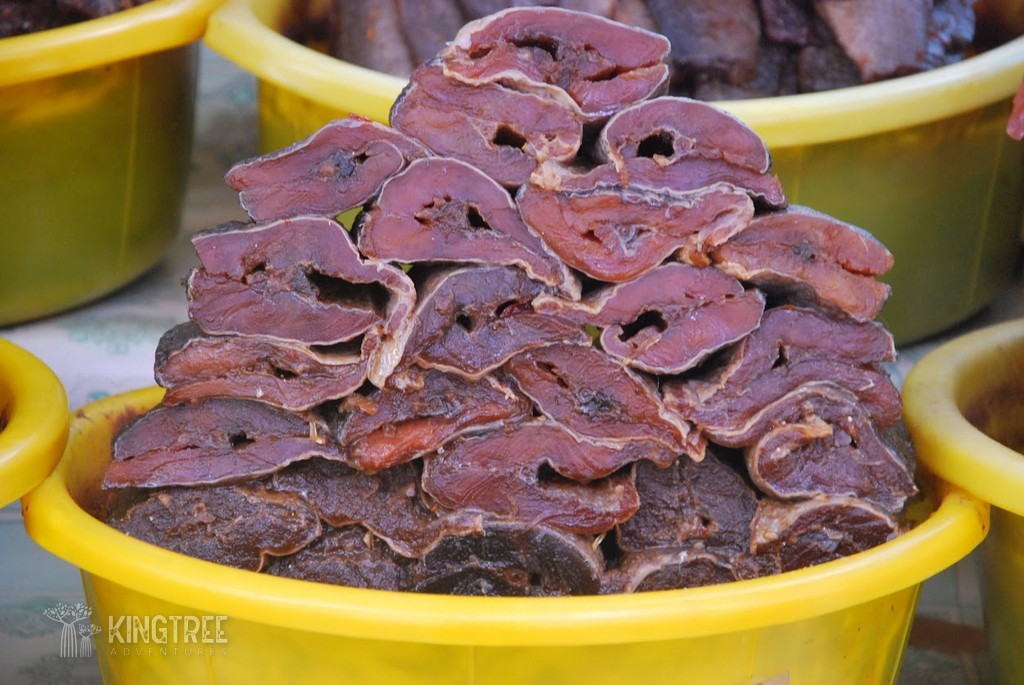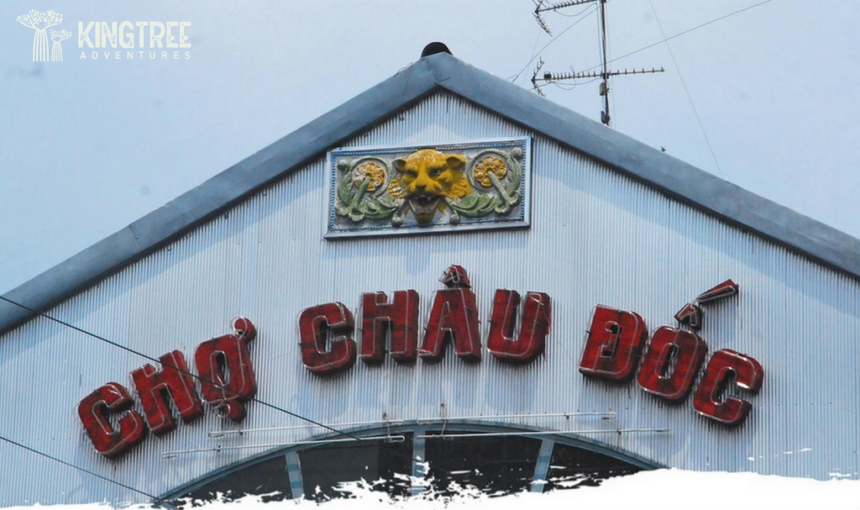Chau Doc Market is situated at the confluence of the Tien and Hau Rivers, offering a unique and vibrant atmosphere. The market is particularly renowned for its preserved fish products, which create a distinctive scene and provide numerous opportunities for exotic photography.
The History of Chau Doc Market
The Chau Doc Market building has a rich history that dates back to the early 19th century. The market and the town itself were established in 1819 under the command of the Vietnamese king, marking the beginning of Chau Doc’s development as a trading hub.
In 1914, the French colonial authorities constructed the current market building. They designed it with a steel frame structure, which was a significant architectural feat at the time, and covered it with terra cotta tiles. This design reflects French colonial influence and is a notable feature of the market.
Over the years, the building has undergone several renovations to preserve its structure and adapt to the growing demands of the market. The most recent renovation took place in 1998, ensuring the market’s continued operation and its place as an iconic site in Chau Doc. Despite the changes over time, the market building has retained its historic charm, serving as both a functional space for local commerce and a symbol of the town’s cultural and architectural heritage.
Chau Doc Market’s Notable Specialties

Dried Fish (Kho)
Dried fish, known locally as “kho”, is a signature specialty of Chau Doc, deeply rooted in the region’s culinary traditions. Made from freshwater fish like pangasius (catfish) and other species from the Mekong River, dried fish is a popular preservation method. The fish is first cleaned and salted, then sun-dried or smoked, a process that enhances the natural flavors and creates a savory, chewy texture. This preservation method allows the fish to be stored for long periods, making it a reliable food source in the humid climate of the Mekong Delta.
Dried fish is used in various dishes, such as flavoring soups, broths, and stews, where it adds depth and umami to the meal. It can also be grilled and served with rice for a simple, satisfying meal. In Chau Doc, dried fish is a key market specialty, with vendors offering a range of dried fish products, making it a must-try for visitors exploring the local cuisine.
Fermented Fish (Mam)
Fermented fish, or “mam”, is a unique and beloved specialty in Chau Doc, reflecting the region’s deep connection to the Mekong River. Mam is made by preserving fish, typically pangasius (catfish), with salt, palm sugar, chili, garlic, and sometimes roasted rice powder. The fish is deboned, and the mixture is left to ferment, resulting in a strong, savory, and slightly tangy flavor. Some variations also include shredded green papaya for added texture and flavor.
This preserved fish product is incredibly versatile in local cuisine. It is commonly used as a base for soups, fondues, and vermicelli dishes, adding depth and umami to the meals. Mam is also used as a salty dip, often paired with fresh vegetables, boiled meats, or rice. Available in Chau Doc Market, mam is a key element of the area’s culinary identity, offering a bold taste of the region’s heritage and food culture.
Other Specialties at Chau Doc Market
Tung lamaow
A lesser-known yet intriguing specialty at Chau Doc Market is “tung lamaow”, a unique beef sausage that adds an extra layer of flavor to the region’s diverse culinary offerings. Originating from the Cham people, an ethnic group with a rich cultural history in Southeast Asia, particularly in Vietnam and Cambodia, tung lamaow is made from finely minced beef mixed with various spices, herbs, and sometimes rice powder or fillers. The mixture is then stuffed into natural casings, often from beef intestines, and dried or smoked to preserve the sausage. The result is a savory, slightly chewy sausage with a rich, aromatic taste that is spiced but not overwhelmingly hot.
Popular in the Chau Doc region, tung lamaow reflects Cham culinary traditions and is often enjoyed as a snack or paired with rice, vegetables, or pickled dishes. It is also included in soups and stews, making it a sought-after delicacy at the market. Visitors can sample it alongside other local specialties like dried and pickled fish, offering a taste of the Mekong Delta’s cultural and culinary diversity.
Palm Sugar
Palm sugar is a key local specialty in Chau Doc, reflecting the region’s agricultural traditions. Made from the sap of sugar palm trees, this natural sweetener is commonly used in Southeast Asian cuisine, particularly in traditional Vietnamese and Cambodian dishes. Known for its rich, caramel-like flavor, palm sugar adds depth to both savory and sweet meals.
To make palm sugar, sap is collected from flower buds, boiled into syrup, and poured into molds to harden into blocks or cakes. It has a golden-brown color and a slightly smoky taste, distinct from refined cane sugar.
At Chau Doc Market, palm sugar is sold in blocks, cakes, or grated form. It’s used in dishes like mam (fermented fish) or sweet desserts, and pairs well with market specialties such as dried fish. Palm sugar is a must-try for those exploring the authentic flavors of the Mekong Delta.
Signature Food at Chau Doc Market
Bún Cá Chau Doc is a flavorful local specialty from the Mekong Delta, featuring fresh fish, aromatic broth, and rice noodles (bún). The dish typically uses pangasius (catfish), abundant in the Mekong River. The fish is either fried or grilled before being added to the soup, which imparts a smoky, savory flavor that complements the other ingredients.
The rich broth is made by simmering fish bones, flavored with lemongrass, garlic, onions, and turmeric, giving it a golden hue and a fragrant, complex taste. Garnished with fresh herbs like sesban, cilantro, basil, and bean sprouts, it’s balanced with lime and chili. Additional pickled vegetables and fried shallots enhance texture and flavor.
Typically served as breakfast or lunch, Bún Cá Chau Doc can be enjoyed at any time of day. It reflects influences from Khmer cuisine, especially with the use of herbs like lemongrass and turmeric, representing a fusion of local and Cambodian culinary traditions.
Fun Ride on a Xe Loi to Chau Doc Market
The market bustles with life, offering a vibrant and colorful atmosphere. Visitors should take a stroll through the various stalls, soaking in the energetic vibe of this lively marketplace. An interesting way to go to the market is to hop on a “xe loi”. The vehicle consists of a motorcycle or scooter at the front, which is attached to a wooden or metal cart. The cart can carry several passengers or be used to transport goods such as produce, fish, or other local products. Some xe loi are customized for specific purposes, such as selling snacks, fruits, or drinks, turning them into mobile street vendors. In Chau Doc, xe loi is not only a common sight on the streets but also a part of the local charm offering a fun way to explore the town and nearby attractions.
Facts
- Address: Bach Dang St, Chau Doc City, An Giang Province
- Coordinate: 10.711313, 105.118799
- Opening hours: 05:30-18:00
- Entrance fee: Free
- Category: Day-to-day life
- Best months to visit: All months






